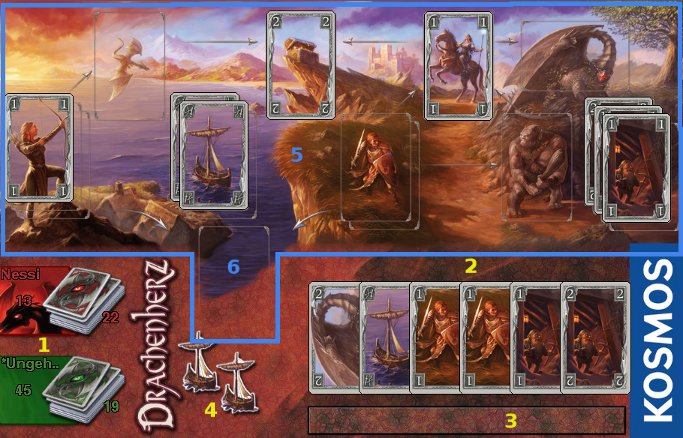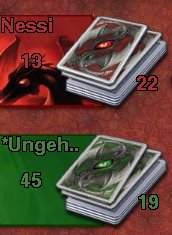Drachenherz
Starting the Game
With /join 2 players can join the game. With /start the game begins. Alternatively, you can use the Game Tool!
Object of the Game
Dragonheart is a card game for two with simple rules. The rules change as the cards are played. Each player tries to score as many points with the cards they have been dealt.
Game Board

- Player Dashboard
- Cards in hand
- Acknowledgment Bar.
- Round Indicator
- Card Play Area
- Card Collection Area

The players display below shows the player's name, the number of collected cards (not the score!). To the right you see the number of cards in the deck. The dragon image (here the red player) indicates that this player is currently in possession of the dragon figure.
Gameplay< /span>
Each player has an identical set of 50 cards. Each deck includes treasure chests, fire dragons, stone dragons, princesses, heroes, trolls, dwarves and ships, each with different values. These are played in the respective spaces on the board. Depending on the relationship between the cards when you play, one or more cards become available. These cards can be collected for the end of the game where they count as victory points. The association of the cards and how they affect the game play is depicted by arrows on the game board.
Flow of the game
Each player starts with five cards in their possession. During their turn, each player may put one or more of the same type on the board. Card types are always placed at the corresponding space. To do this, players click on all of the cards they wish to play and then click on the bar (3) located below their hand cards. The hand is then made back up to five cards.
There are two types of locations on the board: the multi-stack locations (fire dragon, princess, trolls and petrified dragon ) where any number of cards of that type may be stacked. They have a simple outline. There are also the locations which trigger immediately a certain number of that card is placed there. In these action spaces only the maximum number of cards outlined can be placed here (four dwarves, two heroes, etc.). So if three dwarfs have already been played, then you can no longer play two dwarf cards, only one. An action here is only triggered when all required cards to trigger the action have been placed.
If a fire dragon card is played, then an action is immediately performed (take all treasure chests). If he plays a dragon slayer, he can only perform the "take fire dragon" when he places the third dragon slayer.
The Cards
Treasure Chests

You do not get anything for playing treasure chest cards (there are no arrows pointing from the treasure chest to another card types). By playing treasure chest cards you are investing for future game moves when they can be taken by another card type (fire dragon, princess).
Fire Dragon

When playing a fire dragon, the player may immediately take all Treasure Chest cards.
Dragon Slayer

Playing dragon slayer cards will not trigger an action until the third card is played (quantity silhouette!) Once the third dragon slayer is played, it will take all of the fire dragons. The Dragon hunters are then placed in the Card Collection area (6).
Stone Dragon

No actions are triggered by placing stone dragons. They can however be taken by the princess.
Princess

A princess can immediately take either all of the treasure chests or all of the stone dragons. If several princesses are played, you may still only select one of the two stacks. If you choose the stone dragon stack, you can also claim the dragon figure, which lets you hold one extra card in your hand.
Hero

Playing hero cards will not trigger an action until the second hero card is played (quantity silhouette!) Playing the second hero card lets you take either all princess cards or all troll cards. The two hero cards are then placed in the discard area (6).
Troll

When laying a troll you immediately take all the princesses.
Dwarf

Playing dwarf cards will not trigger an action until the fourth card is played (quantity silhouette!) When the fourth dwarf is played, the player simply take all four dwarfs.
Ship

Playing ship cards will not trigger an action until the third card is played (quantity silhouette!). When the third ship card is played, you take all the cards which have been stacked in cards in the Card Collection Area (6). Each time a grouping of 3 ship cards is played and the Card Collection Area is emptied, the incremental ship symbol is added to the display (4).
The Dragon
The player, who first takes a stone dragon with a princess, receives the dragon figure. If you opponent then takes a stone dragon, the dragon figure goes to him. One card is selected at random from the previous player and given to the new owner of the dragon figure (they must always have 6 cards). The player who possesses the dragon figure at the end of the game receives three extra points.
End of the Game
Once the round indicator (4) shows three ship symbols (that is the Card Collection Area has been emptied three times), the game ends. If a player's deck has been completely used up before the three ships departed, ending the game ends after his next turn. In both cases, the other player is allowed to make one last turn. The player with the most points wins (total number of points taken from the cards plus the 3 points for the dragon figure). In the case of a draw, the player with the dragon figure wins.
Game Options
match X
With the Option /match X you can set the match to end when a player has X victories.
sumof >
With the Option /sumof X you can set a match to a specific number of games. When those games have been played, the player with the highest total of points from those games, is the winner.

